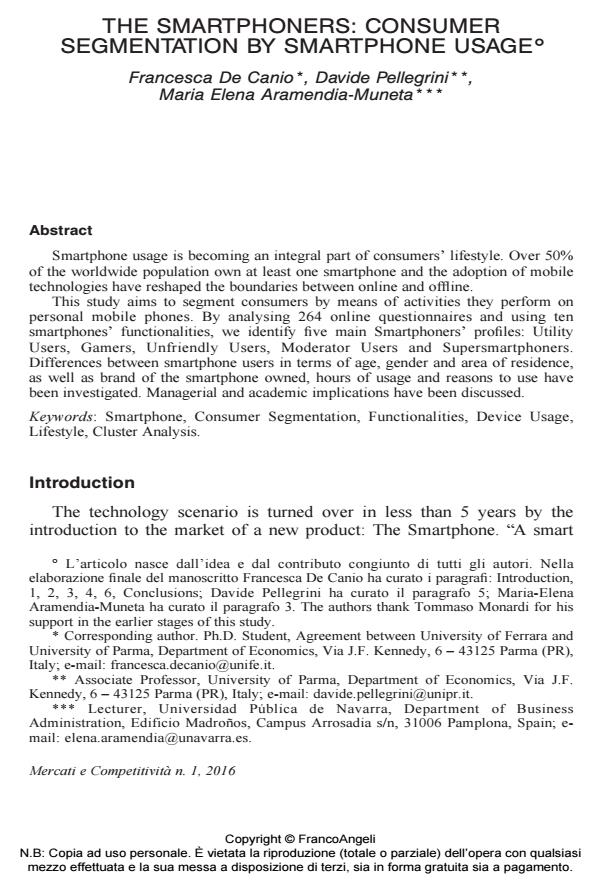The smartphoners: consumer segmentation by smartphone usage
Journal title MERCATI E COMPETITIVITÀ
Author/s Francesca De Canio, Davide Pellegrini, Maria Elena Aramendia-Muneta
Publishing Year 2016 Issue 2016/1
Language English Pages 22 P. 123-144 File size 135 KB
DOI 10.3280/MC2016-001007
DOI is like a bar code for intellectual property: to have more infomation
click here
Below, you can see the article first page
If you want to buy this article in PDF format, you can do it, following the instructions to buy download credits

FrancoAngeli is member of Publishers International Linking Association, Inc (PILA), a not-for-profit association which run the CrossRef service enabling links to and from online scholarly content.
Smartphone usage is becoming an integral part of consumers’ lifestyle. Over 50% of the worldwide population own at least one smartphone and the adoption of mobile technologies have reshaped the boundaries between online and offline. This study aims to segment consumers by means of activities they perform on personal mobile phones. By analysing 264 online questionnaires and using ten smartphones’ functionalities, we identify five main Smartphoners’ profiles: Utility Users, Gamers, Unfriendly Users, Moderator Users and Supersmartphoners. Differences between smartphone users in terms of age, gender and area of residence, as well as brand of the smartphone owned, hours of usage and reasons to use have been investigated. Managerial and academic implications have been discussed.
Keywords: Smartphone, Consumer Segmentation, Functionalities, Device Usage, Lifestyle, Cluster Analysis
- The second-level smartphone divide: A typology of smartphone use based on frequency of use, skills, and types of activities Alexander Wenz, Florian Keusch, in Mobile Media & Communication /2023 pp.459
DOI: 10.1177/20501579221140761 - Green Products in the Fashion Industry: Consumer Segmentation to Develop Communication Campaigns Laura Martinez-Huete, Maria Elena Aramendia-Muneta, in Fashion Practice /2025 pp.105
DOI: 10.1080/17569370.2024.2426647 - Differences in the perceived financial risk factors between digital natives in the e-commerce Richard Fedorko, Veronika Skerhakova, Stela Markova, Radovan Bacík, Lubomir Fejercak, in Marketing and Management of Innovations /2021 pp.137
DOI: 10.21272/mmi.2021.4-11 - Occupational and Environmental Safety and Health VI Ljupcho Efremov, Elsa Abboud, pp.255 (ISBN:978-3-031-82290-2)
Francesca De Canio, Davide Pellegrini, Maria Elena Aramendia-Muneta, The smartphoners: consumer segmentation by smartphone usage in "MERCATI E COMPETITIVITÀ" 1/2016, pp 123-144, DOI: 10.3280/MC2016-001007